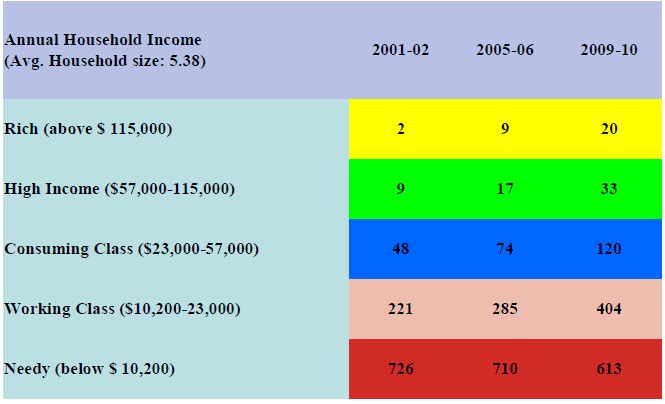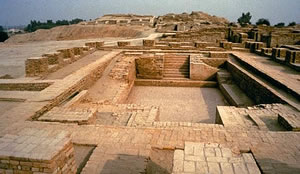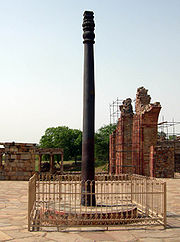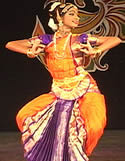INDIA...
Please Click on Play Button twice to start the Flash...Please click on replay to play again..
India is a republic consisting of 28 states and seven union territories with a parliamentary system of democracy. It has the world's twelfth largest economy at market exchange rates and the fourth largest in purchasing power. Economic reforms have transformed it into the second fastest growing large economy. However India also sufferswith poverty, malnutrition, unemployment... Click Here to have a look st some key facts. The name India is derived from Indus, which is derived from the Old Persian word Hindu, from Sanskrit Sindhu, the historic local appellation for the Indus River. The ancient Greeks referred to the Indians as Indoi , the people of the Indus. The Constitution of India and common usage in various Indian languages also recognise Bharat as an official name of equal status. Hindustan , which is the Persian word for �Land of the Hindus� and historically referred to northern India, is also occasionally used as a synonym for all of India. One can appreciate the presence of lofty mountains in the north; large rivers such as Ganga, Brahmaputra, Mahanadi, Krishna, Godavari and Kaveri; green forested hills in northeast and south India; and the vast sandy expanse of Marusthali. India is bounded by the Himalayas in the north, Hindukush and Sulaiman ranges in the northwest, Purvachal hills in the north-east and by the large expanse of the Indian ocean in the south, it forms a great geographic entity known as the Indian subcontinent. It includes the countries � Pakistan, Nepal, Bhutan, Bangladesh and India. The Himalayas, together with other ranges, have acted as a formidable physical barrier in the past. Except for a few mountain passes such as the Khyber, the Bolan, the Shipkila, the Nathula, the Bomdila, etc. it was difficult to cross it. It has contributed towards the evolving of a unique regional identity of the Indian subcontinent. |
INDIA a country with with a rich history, a rich civilization which is an amalgam of some of the greatest civilizations and cultures of the world. It always stood as a peace loving country. The Indian Indepence sttrugle and the way it has developed in many fields during the last 59 years of its Independence, is a source of inspiration for the third world countries and an eye opener for advanced countries . India has become self-sufficient in agricultural production( when in 1970s some eminent international economists warned that India is going towards a dead wall-- thanks to Green Revolution), and is now the tenth industrialised country in the world and the sixth nation to have gone into outer space to conquer nature for the benefit of the people. The mainland of India, extends from
Kashmir in the north to Kanniyakumari in the
south and Arunachal Pradesh in the east to
Gujarat in the west. India�s territorial limit
further extends towards the sea upto 12
nautical miles (about 21.9 km) from the coast.It covers an area of 32,87,263 sq km, extending from the snow-covered Himalayan heights to the tropical rain forests of the south. As the seventh largest country in the world, India stands apart from the rest of Asia, marked off as it is by mountains and the sea, which give the country a distinct geographical entity. Bounded by the Great Himalayas in the north, it stretches southwards and at the Tropic of Cancer, tapers off into the Indian Ocean between the Bay of Bengal on the east and the Arabian Sea on the west.
Lying entirely in the northern hemisphere, the mainland extends between latitudes 8�4' and 37�6' north, longitudes 68�7' and 97�25' east, and measures about 3,214 km from north to south between the extreme latitudes and about 2,933 km from east to west between the extreme longitudes. It has a land frontier of about 15,200 km. The total length of the coastline of the mainland, Lakshadweep Islands, and the Andaman and Nicobar Islands is 7,516.6 km.Sri Lanka and Maldives are the two island
countries located in the Indian Ocean, which
are our neighbours. Sri Lanka is separated from
India by the Gulf of Mannar and Palk Strait. |
The Section is not Complete.. we will be updating it soon
"Civilizations have arisen in other parts of the world. In ancient and modern times, wonderful
ideas have been carried forward from one race to another...But mark you, my friends, it has been always
with the blast of war trumpets and the march of embattled cohorts. Each idea had to be soaked in a deluge
of blood..... Each word of power had to be followed by the groans of millions, by the wails of orphans, by the
tears of widows. This, many other nations have taught; but India for thousands of years peacefully existed.
Here activity prevailed when even Greece did not exist... Even earlier, when history has no record, and
tradition dares not peer into the gloom of that intense past, even from until now, ideas after ideas
have marched out from her, but every word has been spoken with a blessing behind it and peace before it.
We, of all nations of the world, have never been a conquering race, and that blessing is on our head,
and therefore we live.... !---Swami Vivekananda, Great Indian Philosopher
Those were the words of Swami Vivekananada,there is not even a pint of exaggeration in that statement.If you say its an Indian bosting of his own country,Great American Philospher Will Durant's statement is quoted here,this tells the greatness of India.
India was the mother of our race and Sanskrit the mother of Europe's languages. She was the
mother of our philosophy, mother through the Arabs, of much of our mathematics, mother through
Buddha, of the ideals embodied in Christianity, mother through village communities of self-government
and democracy. Mother India is in many ways the mother of us all-Will Durant
The list of such exclamations is never ending.Please click here for some of such qoutes about the brilliant nation
India is the country that always stood with pride... Starting with we just add some great ancient inventions of Indians which were later rediscovered by the Western World...
The Ancient Indian Inventions
The Indus civilization one of the earliest civilizations of the world.Its still unclear when this civilization existed on the earth. Indus citizens(its an urban civilization) cultivated cotton,there is irrigation system,well laid roads/lanes with name plates. The Indus script hasn't been deciphered till now.They have standard weights and measures.And Lothal has the world's first dock. These are just a few inventions of a very ancient civilization...Please click here to know more about Indus Valley Civilization
Lagadha wrote the first astronomical text in 1300 BC.The Vedānga Jyotiṣa also details astronomical calculations, calendrical studies, and establishes rules for empirical observation. Baudhayana (800 BC) gave the 'Pythagoras theorem' centuries before the Greek. Baudhayana gives a formula for the square root of two.
Cataract surgery was known to the Indian physician Sushruta (6th century BCE).Kearns & Nash (2008) state that the first mention of leprosy is described in the Indian medical treatise Sushruta Samhita (6th century BCE).
Panini (400 century BC) has been called the greatest genius who ever lived: his grammar of the Sanskrit language is exhaustive and yet it uses only 4,000 computer program-like rules. Pingala (400 BC) invented the binary number system (counting by 0s and 1s) that, 2,500 years later, turned out to be basic to computer operations.
The Arthashastra of Kautilya mentions the construction of dams and bridges.Indigo is used as a dye in India, which was also the earliest major center for its production and processing.
Pingala (fl. 300-200 BCE), a musical theorist who authored a Sanskrit treatise on prosody. There is evidence that in his work on the enumeration of syllabic combinations, Pingala stumbled upon both the Pascal triangle and Binomial coefficients, although he did not have knowledge of the Binomial theorem itself.The first description of binary numbers is also found in the works of Pingala.The decimal number system originated in India.
Indian scholar Brahmagupta (598–668) was able to find (integral) solutions of Pell's equation.The earliest conceptual design of a perpetual motion machine dates back to 1150, by an Indian mathematician-astronomer, Bhaskara II. He described a wheel that he claimed would run forever.The trigonometric functions of Sine and 'Versine, from which it was trivial to derive the Cosine, were discovered by the Indian mathematician, Aryabhata, in the late 5th century.The calculus theorem now known as "Rolle's theorem" was first stated by the Indian mathematician, Bhāskara II, in the 12th century.[79] In the 12th century, Bhāskara II developed the concept of a derivative and a differential representing infinitesimal change.
The first iron pillar was the Iron pillar of Delhi, erected at the times of Chandragupta II Vikramaditya (375–413).The pillar was made by the technique of forged welding. If chinese were pioneers in ceramics, Indians were unprecedent pioneers in Metallurgy. Even evidences of Zinc extraction are also found.
Mâdhava (c 1340-1425) and Nîlakantha (c 1444-1545), who made fundamental contributions to power series, calculus and astronomy, are amongst the greatest scientists who have ever lived. Their invention of calculus came two hundred years before Newton and Leibnitz.....
The Inventions goes on. We only call something science when it comes from western world and some one scientist when he gets Nobel Prize.But these inventions were all done well before other countries were struggling for subsistence...
Please Click Here to know more about the Indian Science.
India-The Growing Super power
India’s economy has been one of the stars of global economics in recent years, growing 9.2% in 2007 and 9.6% in 2006. Growth had been supported by markets reforms, huge inflows of FDI, rising foreign exchange reserves, both an IT and real estate boom, and a flourishing capital market.The positive point is the expanding consumer,middle income,high income families..A list is given below.
India Population Distribution-Income wise

India-Billion Dreams- Billion Aspirations
A nation ruled by many dynastys,a civilization metamorphosis-ed by many great cultures.The Nation that always welcomed,attracted the people of the world. The rich kaledoscopic unique culture, an amalgam of many wide varities... no where You can find a nation like India.
Chandra Gupta Maurya, Asoka, Kanishka, Harshavardhana , Akbar... the list is never ending. Many great writers tried to picture its glory in words, but only were capable to project part of it.
Neither was an army ever sent outside the country by the Indians nor did any outside army ever invade their
country and master them, except that with Heracles and Dionysus and that in our times with the
Macedonians.- Megasthenes in His Indika
The Indian people are said to live very long lives, over one hundred years.Polygamy is a common practice
Strabo remarks that their customs are simpler than the Greeks, but they do have a fondnes for jewelry.
- Strabo's Account of India
Starting way back from the Indus Civilization... It begins with a mysterious culture along the Indus River and in farming communities in the southern lands of India. The history of India is punctuated by constant integration of migrating people with the diverse cultures that surround India. Available evidence suggests that the use of iron, copper and other metals was widely prevalent in the Indian sub-continent at a fairly early period, which is indicative of the progress that this part of the world had made. By the end of the fourth millennium BC, India had emerged as a region of highly developed civilization.the saga of India had a complex web of many dynatys,foreign Invasions and still standing with all the Pride..
A very brief account of Indian History is Presented Here.. We try to provide more details in the India History Section..
Indus Civilization

- Great Bath:Mohenjo-Daro
Ancient India & Indian History..
The Vedic civilization is the earliest civilization in the history of ancient India associated with the coming of Aryans. It is named after the Vedas, the early literature of the Hindu people. The Vedic Civilization flourished along the river Saraswati, in a region that now consists of the modern Indian states of Haryana and Punjab. Vedic is synonymous with Aryans and Hinduism, which is another name for religious and spiritual thought that has evolved from the Vedas. The largely accepted view is that a section of Aryans reached the frontiers of the Indian subcontinent around 200 BC and first settled in Punjab and it is here, in this land, where the hymns of Rigveda were composed.The Ramayana and Mahabharata were the two great epics of this period.
The advent of Buddhism is the first stand-point in the annals of India.Buddha was born in BC 560 and died at the age of eighty in BC 480. The place of his birth was a grove known as Lumbini, near the city of Kapilavastu, at the foot of Mount Palpa in the Himalayan ranges within Nepal. Buddha, whose original name was Siddhartha Gautama, was the founder of Buddhism, the religion and the philosophical system that evolved into a great culture throughout much of southern and eastern Asia.
Alexander and his army reached the mouth of the Indus in July 325 BC, and turned westward for home.The Mauryan Empire, The Gupta Dynasty , Harshavardhana, The Pallavas, The Chalukyas... Ruled the Indian territory.Sangam literature flourished in the early centuries. The history continues... Please click here to know more
The Village communities are little republics having nearly everything they can want within themselves and
almost indepenent of any foreign relations.They seem to last when nothing else losts.Dynasty after dynasty
remains the same;Revolution suceeds to revolution;Hindu,Pathan,Moghul,English,Sikh are all masters in
turn;but the Village communiy remains the same-Lord Metcalf






